 W
WIn the 1890s, an epizootic of the rinderpest virus struck Africa, considered to be "the most devastating epidemic to hit southern Africa in the late nineteenth century". It killed more than 5.2 million cattle south of the Zambezi, as well as domestic oxen, sheep, and goats, and wild populations of buffalo, giraffe, and wildebeest. This led to starvation resulting in the death of an estimated third of the human population of Ethiopia and two-thirds of the Maasai people of Tanzania.
 W
WAcacia sassa is a legume that grows in the forests of Senegal. It was first described by Carl Ludwig von Willdenow. Smoke from certain parts of it is known to be psychoactive.
 W
WAfrica Today is an academic journal with articles about contemporary Africa. It encourages interdisciplinary research and seeks to be a venue for diverse perspectives on a broad range of topics. The editors accept submissions based on original research in any humanities and social science discipline. Special issues focus on complex topics from multiple perspectives. It is published by the Indiana University Press. According to Project Muse, it "publishes peer-reviewed, scholarly articles and book reviews in a broad range of academic disciplines on topics related to contemporary Africa" and "seek[s] to be a venue for interdisciplinary approaches, diverse perspectives and original research in the humanities and social sciences."
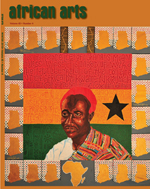 W
WAfrican Arts is a peer-reviewed academic journal devoted to the study and discussion of traditional, contemporary, and popular African arts. It was founded in 1967 and is published online and in hard copy by the MIT Press, which distributes the journal for the James S. Coleman African Studies Center at the University of California, Los Angeles.
 W
WAfrican century is the belief or hope that the 21st century will bring peace, prosperity and cultural revival to Africa. Among those who have spoken of an African century are South African politicians Thabo Mbeki and Nkosazana Dlamini-Zuma, Chevron CEO David J. O'Reilly, US Treasury Secretary Paul O'Neill and celebrity campaigner Bono. It has also inspired a radical policy journal - African Century Journal founded in 1999.
 W
WThe African Union High Representative for Infrastructure Development post was created in October 2018 by the African Union Commission Chair Moussa Faki The first and current High Representative is Raila Odinga, Leader of the Opposition and former Prime Minister of Kenya (2008-2013), who was appointed on 20 October 2018 by the Chairperson of the African Union Commission. Prior to this appointment, the Directorate of Trade and Industry was headed by Elisabeth Tankeu.
 W
WAfrican Union of Broadcasting is a professional body composed of the national radio and television organizations of African states. The organization is committed to the development of all aspects of broadcasting in Africa including the exchange of indigenous programming. It is headquartered in Dakar, Senegal.
 W
WThe Agbudu shooting was a mass shooting on 30 July 2020 in Agbudu village, Kogi State, Nigeria. The attack left 14 people dead and another 6 injured. Thirteen of the dead were members of the same family. Police said that a long-standing row over land rights is suspected to be the motive behind the attack.
 W
WBalgha, also spelled balga, belgha, or belga, are heelless slippers made from leather. They are part of traditional dress of the Muslim world and are related to Ancient Asia and the Chinese civilization.
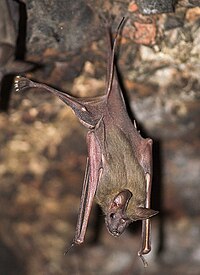 W
WThe greater mouse-tailed bat is a species of bat in the Rhinopomatidae family.
 W
WThe Biafran pound was the currency of the breakaway Republic of Biafra between 1968 and 1970.
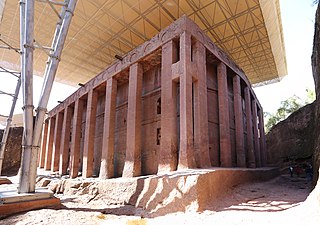 W
WBiete Medhane Alem is an Orthodox underground monolith rock-cut church located in Lalibela, Ethiopia. It was built during the Zagwe dynasty. It is part of the UNESCO World Heritage Site at Lalibela. Biete Medhane Alem is home to the Lalibela Cross.
 W
WBill Bryson's African Diary is a 2002 book by best-selling travel writer Bill Bryson. The book details a trip Bryson took to Kenya in 2002. Bryson describes his experiences there and observations about Kenyan culture, geography, and politics, as well as his visits to poverty-fighting projects run by CARE International, to which he donated all royalties for the book.
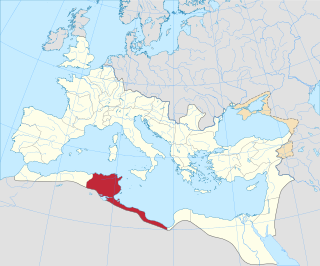 W
WBulnensis also known as Bulna is a titular episcopal see of the Roman Catholic Church ascribed to the ecclesiastical province of Africa Proconsularis, as a suffragan of the Archdiocese of Carthage.
 W
WThe Coat of Arms of the British Indian Ocean Territory was granted in 1990 on the 25th anniversary of the territory's establishment.
 W
WThe Commissioner for the British Indian Ocean Territory is the head of government in the United Kingdom's overseas territory of the British Indian Ocean Territory. The Commissioner is appointed by the British monarch on the advice of the Foreign and Commonwealth Office. The Commissioner does not reside in the territory, as it has had no native population since the forced depopulation of the Chagossian people in the 1970s, and the only population is the military of the United States and the United Kingdom at the joint base at Diego Garcia.
 W
WThe Development Bank of the Central African States, usually known for its French initials, BDEAC, is a multilateral development bank that is charged with financing the development of the member states of Economic and Monetary Community of Central Africa (CEMAC). The BDEAC is different from the Bank of the Central African States (BEAC), which is a central bank.
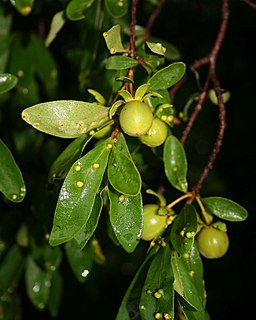 W
WDiospyros lycioides, commonly called the bushveld bluebush, is a species of African Diospyros. It is native to central and southern Africa, except the winter-rainfall area. It appears in Australia and is known as a weed there. Its root and stem are used as toothbrushes, and its wood is used for spoons, toys, construction, and furniture. In South Africa, its fruits are used to make beer and other alcoholic drinks, and its seeds are used as a coffee substitute. It also has many medicinal uses, including treating cold and coughs by chewing the roots, and using the powdered bark of the root as an abortifacient. It has 3-4 subspecies, including Diospyros lycioides subsp. guerkei, Diospyros lycioides subsp. nitens, and Diospyros lycioides subsp. sericea. Its leaves are also food for the Mooi River Opal butterfly, and its flowers are attractive to many animals, namely bees and a few African birds. It can form thickets, and it usually grows up to three meters high, though at its tallest it can be eight meters. It is one of twenty species of Diospyros in Africa.
 W
WA dwa or asesedwa or sometimes gwa is a stool of the Ashantis of Ghana.
 W
WThe yellow-headed dwarf gecko or dwarf yellow-headed gecko is a small species of dwarf gecko found in the rocky areas of southern Kenya, Somalia, eastern Tanzania, and Zanzibar. It can grow up to 90 millimetres (3.5 in), but on average attains a length of 80 millimetres (3.1 in) with a snout-vent (body) length of 39 millimetres (1.5 in). The tail length can be equal to the length of the body from snout to the anus.
The Enough Moment: Fighting to End Africa's Worst Human Rights Crimes is the second book co-authored by actor Don Cheadle, and co-founder of the Enough Project and human rights activist, John Prendergast. Cheadle and Prendergast's first book, Not On Our Watch: The Mission to End Genocide in Darfur and Beyond, was published in 2007.
 W
WFulani proverbs are the folk wisdom of the Fulani people, expressed in their traditional sayings such as "munyal deefan hayre".
 W
WSir Bruce Greatbatch, was the British Governor of the Seychelles from 1969 to 1973.
 W
WLichtenstein's hartebeest is a subspecies of the hartebeest antelope that dwells in savannahs and floodplains of Southeastern-Central Africa. It is sometimes classified as a unique species Sigmoceros lichtensteinii.
 W
WUSNS Henry J. Kaiser (T-AO-187) is a United States Navy replenishment oiler and the lead ship of her class. She is operated by Military Sealift Command and therefore has a "USNS" prefix for United States Naval Ship. She is named for Henry J. Kaiser (1882–1967), an American industrialist and shipbuilder.
 W
WThe International Library of African Music (ILAM) is an organization dedicated to the preservation and study of African music. Seated in Grahamstown, South Africa, ILAM is attached to the Music Department at Rhodes University and coordinates its Ethnomusicology Programme which offers undergraduate and post-graduate degrees in Ethnomusicology that include training in performance of African music. ILAM, as the largest repository of indigenous African music, is particularly known for its study of the lamellophone mbira of Zimbabwe and Mozambique, as well as the Chopi people's Timbila, a variant of the marimba from southern Mozambique.
 W
WThe Journal of African Cultural Studies is a biannual peer-reviewed academic journal covering research on African culture, including African literatures, both written and oral, performance arts, visual arts, music, the role of the media, the relationship between culture and power, culture and gender issues and sociolinguistic topics of cultural interest. It was established in 1988 as African Languages and Culture and obtained its current title in 1998.
 W
WA kifwebe or bwadi bwa kifwebe is a mask of the Songye or Luba of the Congo.
 W
WKigango is a carved wooden memorial statue erected by the Mijikenda peoples of the southeastern Kenya coast. The vigango, which can be stylized, abstracted human-form effigies and are placed vertically rising out of the earth, honor a dead member of the secret Gohu society, or the "Society of the Blessed".
 W
WKinshasa–Brazzaville is a transborder agglomeration comprising Kinshasa, the capital of the Democratic Republic of the Congo, and Brazzaville, the capital of the Republic of the Congo, which face each other across the Congo River. In addition to being the closest national capitals by proximity, it is the third largest urban agglomeration on the African continent, behind Lagos and Greater Cairo, with an estimated population of 12,850,000. The two cities currently do not have a bridge between each other, and numerous attempts to link the two by bridge have yet to materialize.
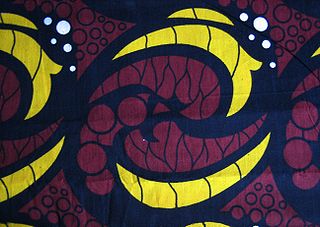 W
WFor the surname, see Kitenge (surname).
 W
WA lipico or lipiko is a mask or helmet of the Makonde of Mozambique.
 W
WThe long-haired rousette is a species of megabat in the family Pteropodidae found in the Democratic Republic of the Congo, Ethiopia, Kenya, Malawi, Rwanda, South Sudan, Tanzania, and Uganda. Its natural habitat is subtropical or tropical moist montane forests.
 W
WThe mtepe is a boat associated with the Swahili people. The mtepe's planks are held together by wooden pegs and coir, so it is a sewn boat designed to be flexible in contrast to the rigid vessels of western technique.
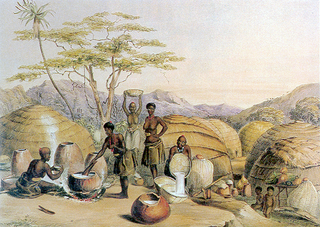 W
WA homestead in southern Africa is a cluster of several houses, typically occupied by a single extended family and often with an attached kraal. Such settlements are characteristic of Nguni-speaking peoples. A house within a homestead is known as an indlu, plural tindlu (Swati) or izindlu.
No Man's Land: An Investigative Journey Through Kenya and Tanzania is a book by the British writer and environmental and political activist George Monbiot.
 W
WNordic Africa Institute serves as a research, documentation and information centre on modern Africa for the Nordic countries. The Institute also encourages research and studies on Africa. The institute was founded in 1962.
 W
WNot On Our Watch: The Mission to End Genocide in Darfur and Beyond is a book co-authored by actor Don Cheadle and human rights activist and co-founder of the Enough Project, John Prendergast.
 W
WParasenegalia visco is a perennial tree found at higher elevations in northern Argentina, Bolivia, Chile and Peru. It has also been introduced to Africa. Common names for it include arca, visco, viscote, viscote blanco and viscote negro. It grows 6–25m tall and it has fragrant yellow flowers in the Spring. In Bolivia is found at an altitude of 1500–3000m.. It has light to dark reddish brown twigs and small white flowers. It is cultivated for use in cabinetmaking.
 W
WRhynchocyon stuhlmanni is a species of Elephant Shrew that lives in forests and savannas in Africa. It was discovered in 1893 and declared a new species. However in the 1960s it was downgraded to a subspecies in checkered sengi. In 2018 using genetic tests, scientists revaluated them to a full species.
 W
WSaba senegalensis known as weda in the Moore, French, and English languages, is a fruit producing plant of the Apocynaceae family, native to the Sahel region of sub-Saharan Africa. It has several common names in various West African Languages. The tree grows predominantly on riverbanks and in woodlands in Burkina Faso, Senegal, Somalia, Mali and Ivory Coast. It has been observed growing as vine up trees, as a small erect shrub, and oftentimes growing to the size of a large tree.
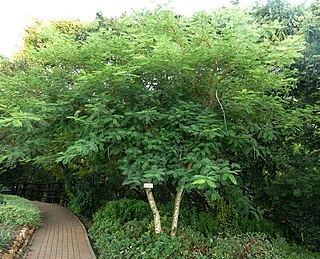 W
WSenegalia polyacantha, also known as White Thorn is a flowering tree which can grow up to 25m tall. Polyacantha has the meaning "many thorns" in Latin. The tree is native to Africa, India, the Indian Ocean and Asia, but it has also been introduced to the Caribbean.
 W
WSenegalia polyacantha subsp. campylacantha is a perennial tree native to Africa. Common names for it are whitethorn and witdoring. It is not listed as being a threatened species. Its uses include wood and medicine.
 W
WA tchitcherik or tchitcherik sakwa is a statue of the ancestors of the Moba of northern Togo and Ghana.
 W
WIn late October 2014, the United Kingdom sent a hospital ship, the Royal Fleet Auxiliary's Argus, to help the aid effort against the Ebola virus disease epidemic in Sierra Leone. By late October Sierra Leone was experiencing more than twenty deaths a day from Ebola.